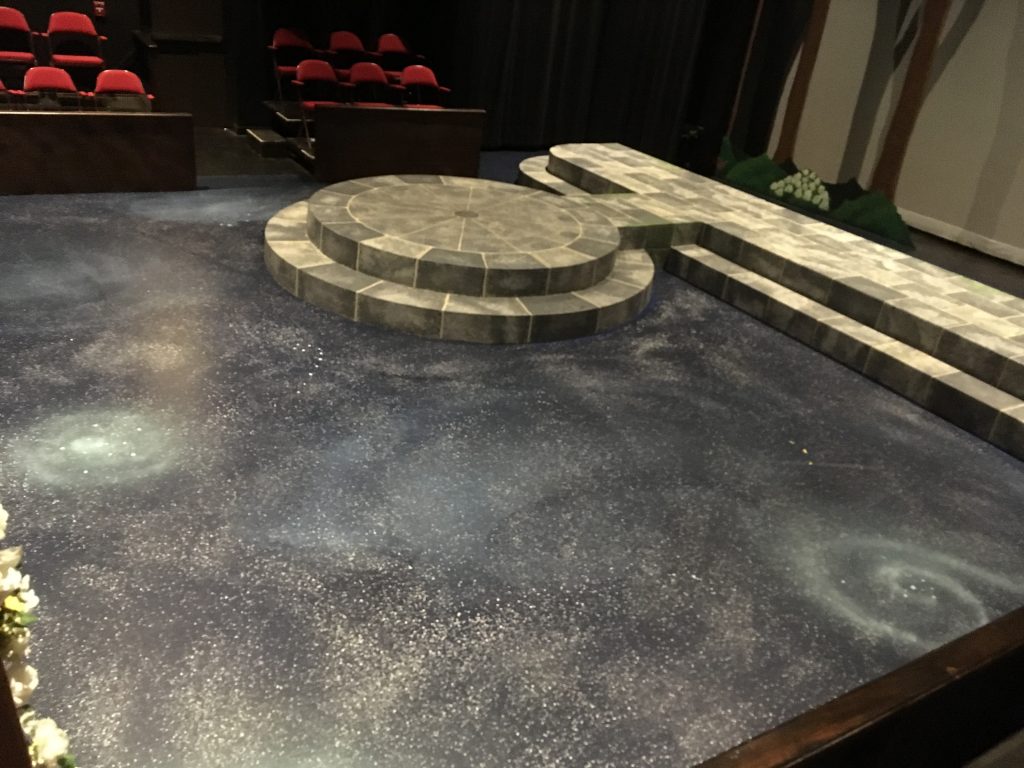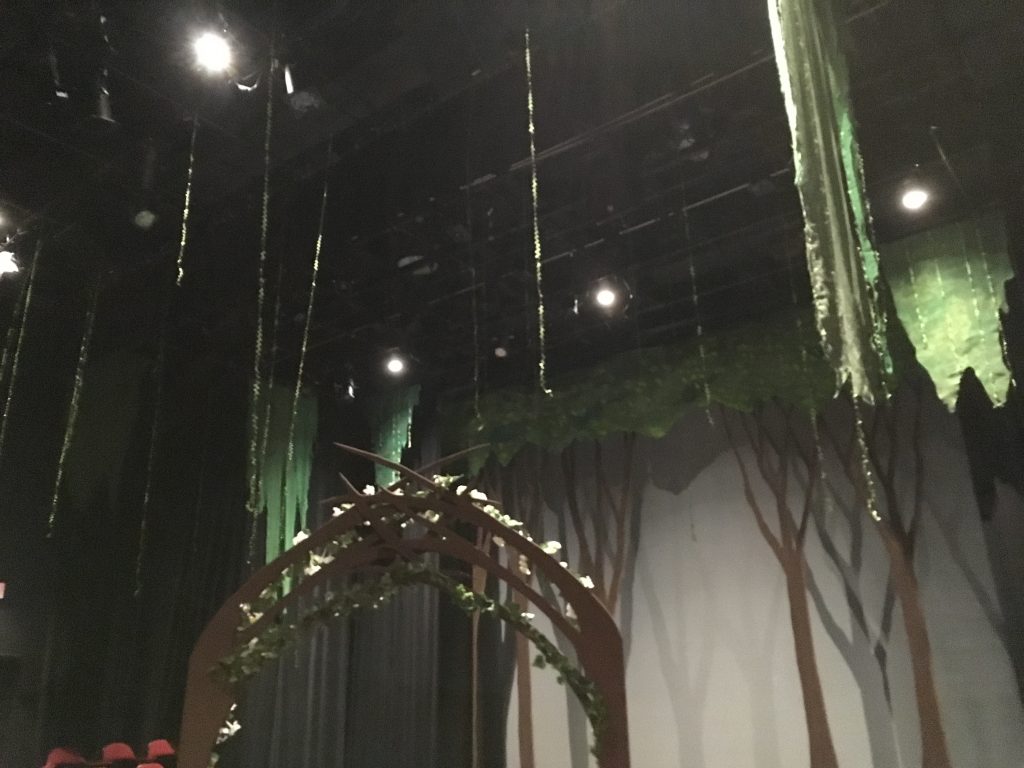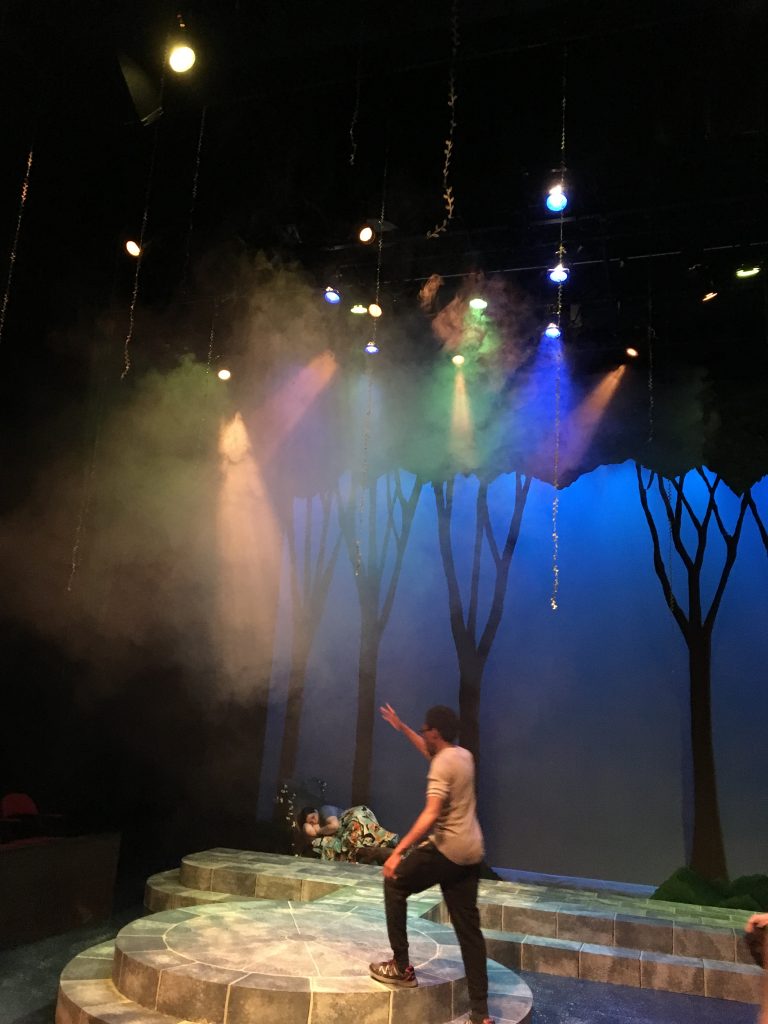An Occasional Midsummer Night’s Dream (David Bowie)
The director chose this as an ensemble piece. It was for tech, too!
February has fallen into a pattern over the past few years. It’s when things start picking back up from the quieter January. The gradual changeover between maintenance, and repair throughout the theatre leading into prep for my usual season of shows coming up. At NVCC, my home theatre department, we usually have our Spring shows in April, so there is time to design and plan, while also getting in a few shows at other theatre companies in the meantime. But, due to some schedule changes, our big Spring show landed at the end of February. It felt like an odd time to put up A Midsummer Night’s Dream.
For this show, I wanted to give my students as much of the reigns as possible – and after our strong productions last semester on “Laramie Project” and :”Next to Normal,” I thought it was high time to let them run things. This gave me an assistant designer (Kaden Dupont) and a system engineer (Chris Varanko), who worked from my overall vision. We all hauled speakers and programed and filled out spreadsheets – but I was able to let them take the lead (which was good, since I ended having conflicts a couple of days and needed them to take charge). We wrapped the show with me feeling very proud of these two – we’ve done a few shows together now as a trio (and Chris and I have had many before that!) and they really came to the table with their own ideas and abilities. I’ve been extremely lucky to have them both, since they’re going to be graduating soon – next year is going to be a year of rebuilding, but we have some great minds coming up the ranks that I look forward to working with.
So, what did we use all of that fire power for? Hasn’t Midsummer been done to death? What new things could we offer? Our director, Sasha Bratt, wanted to present a magical world where anything could happen. So I said “How about pinning the design on the work, and artists influenced by, David Bowie?” Obviously, I was thinking from a sound design frame of mind, but the idea caught fire with the costume designer and Bowie fan Lisa Bebey, and I read Bill Cone’s floor treatment as Sasha’s love for “Starman” (coincidence I’m sure, but I’m taking it).

This led to a few weeks of design time, building loops and stings from a wide library of music. For most of the show, I wanted to steer away from vocals, and keep our music instrumental (though to start the show I found a stunning a capella cover of “Sweet Dreams” by Holly Henry online that I edited to suit my needs). The problem with using such an iconic artist was that there are so many hits, and I wanted to avoid using those big radio hooks, so that we wouldn’t pull people out of the world the show was creating. That guideline, and working with a lot of his 90’s material, put us in danger of “designing a Bowie-themed show without any Bowie,” since casual fans wouldn’t recognize anything for a while once “Starman” wrapped up the house music.
But Kaden and I worked away, sampling bits here and there and blending in effects and other samples to mould the material to what was needed. Songs like “Blackstar” are so involved and intricate, and have so many beautiful themes happening over it’s 10 minute length, ; the only way I could build one of the loops I wanted was to bathe the sample in long delays and reverbs, which made the song sound even more confusingly haunting as it circled in on itself, ouroboros-style. Other songs, like “Dollar Days,” “Pallas Athena,” and “The Wedding” are deep catalog dives that have so much rich texture that we augmented with chimes, cymbals, and more as we built out our loops.
Of course, one of the most obscure songs from the David Bowie catalog that we sampled was the first track from his first, oft-forgotten self-titled album, a song called “Uncle Arthur,” which was the theme for the Mechanicals, the players who perform Shakespeare’s quintessential play-within-a-play. First hearing this song made me realize a) “I have found the perfect music for these clowns,” and b) “I am not surprised that this has not achieved the status of anything from, say, ‘Aladdin Sane’.” It was perfect and adapted well to the pitch bending I applied to it.
There was a random bit of song that one of the actors started singing in rehearsal, and the director wanted to keep it in the show. Titania gets lulled to sleep by one of the fairies (Jalon Coplan) singing Leonard Cohen’s “Hallelujah” – a classic song by one of my favorite writers, but how could we do something fresh with one of the most covered songs of all time? How could we make it work in our world? I was trying to steer towards non-literal sounds where I could (the hunting horns at the end of the show were chopped up, effected samples of didgeridoo, for example). The answer was in having my friend Ryan Fedak, one of Mary’s former students who is up at the Berklee College of Music, record a sparse vibraphone backing track and send it to us as tech started.
Kaden had a few key contributions to the design – the recurring lovers theme between Lysander and Hermia was lifted from the Sword Art Online Soundtrack, a beautiful violin piece called “At Nightfall.” It starts off with this beautiful, recognizable sweeping riff, which we were able to play to great comic effect in one of the scenes. By utilizing a couple of hotkey triggers in Qlab we react to the actors on stage in a dynamic, rather than rehearsed, fashion. This gave us the sound design we wanted while giving the actors room to develop the scene night to night.
Working closely with an assistant designer was a great teaching opportunity – instead of having to direct the minute details of what I wanted, I knew I could trust her to take the guidelines I set out and for her to take that to new places (and find songs from artists like Godspeed You Black Emperor). I taught her how to create random soundscapes using Qlab’s random group setting, a trick I learned in turn from designer Matt Hubbs when we were on “Indecent.” We used random soundscapes throughout the show, including Puck’s Theme, which was based around Nine Inch Nails’ track 6 Ghosts, from the first disc of their 2008 instrumental experiment Ghosts I-IV. For that segment, we used a collection of reversed cymbal samples, which were spread throughout the theatre, to make it even more haunted and twisted.

“Spread throughout the theatre” was the challenge I posited to Chris to figure out as the system engineer. I had ideas of what would essentially be quadrophonic sound for the audience in a 3/4 thrust black box space, with subwoofers added. Ideas like “Oberon, king of the fairies, enters, and samples of his name being whispered by cast members start faintly ping-ponging around the room, under the music.” Between managing assets (we were overhauling the main stage PA system across the hall the same week of load in) and working with the director to find a common ground (speaker placements, actor blocking) I gave him a stated goal and references, letting him sort out the details and do the documentation, supporting him as questions came up.
Overall, it was a very ambitious design, and we were able to pull it off thanks to teamwork. I would be running playback from the tech table in rehearsals, editing Qlab on the fly (combining Nine Inch Nails lilting dirge “Something I Can Never Have” with Bowie’s chugging “All the Madmen” over thunderclaps, depth charges, delays & reverbs, and finding the right amount of brand new subwoofer borrowed from next door), while Kaden was working in my office revising a random soundscape and editing Chris’ new actor voiceovers as they came in, which he was sampling from the green room.

We all had a lot of fun. The cast was amazing – one of the best college shows I’ve ever worked on (that’s a lot of schools and shows). I was really sad when I found out that we weren’t able to extend the run due to schedule conflicts. The enthusiasm and commitment I saw – in my department and all of the others – reinforced my choice for music at curtain call. I re-edited a joyous song from Mika called “We Are Golden” to the length we needed (and the final bow ended right on the button, every time! Long reverb tails for the win!):
“Teenage dreams in a teenage circus
Running around like a clown on purpose
Who gives a damn about the family you come from?
No giving up when you’re young and you want some”
For a list of songs we sampled, check out this link:
https://drive.google.com/open?id=1QZ0ws-mFHlIMcnovLg0cfUA8gH-07RNFOMtOAS2u4MI
-brian
(Our lighting designer, Jon Curns, shot real photos of the show. I’ll come back and update this post when I get them.)